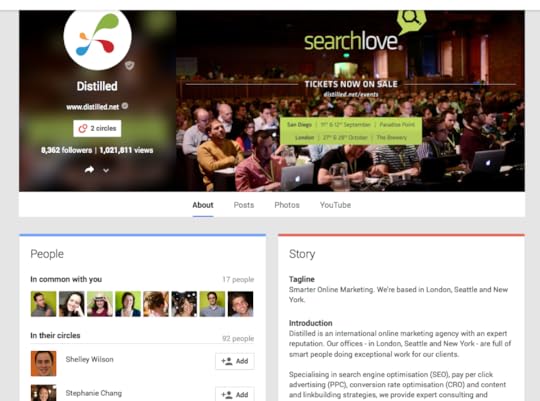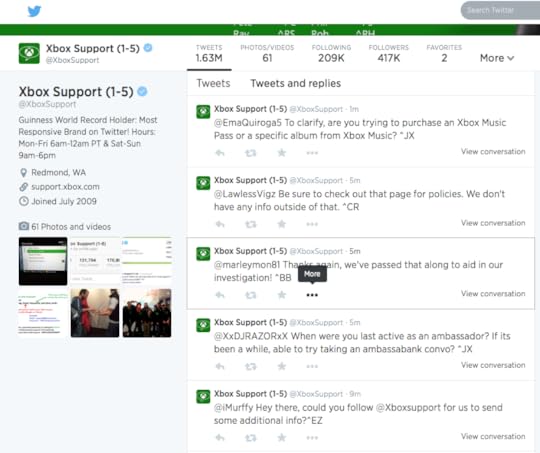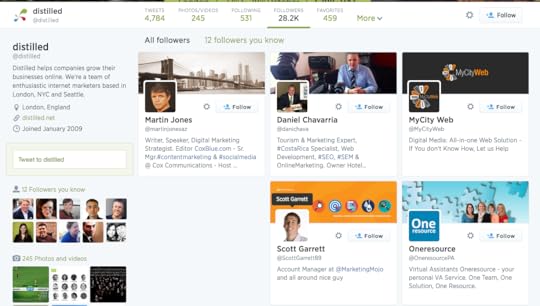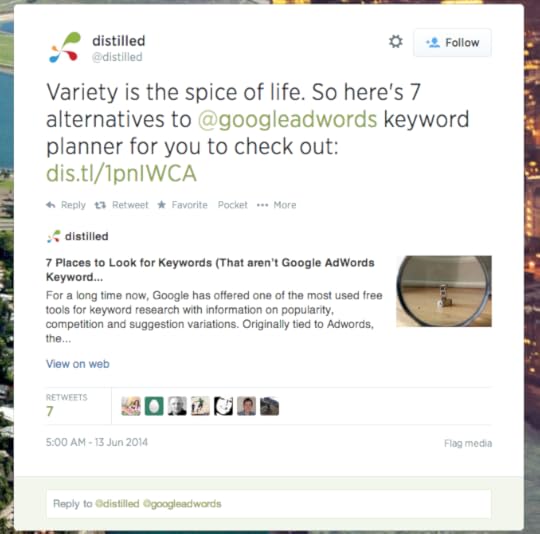Erik Qualman's Blog, page 593
July 30, 2014
LinkedIn’s Best New Tool: Professional Publishing Platform
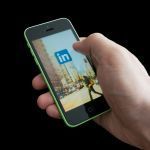
By now, we are all familiar with social media’s viral nature. Speaking on the topic of branding in particular, businesses showcase interesting and unique content across various platforms, hoping to gain widespread awareness for their companies; essentially, hoping to “go viral.” To break it down, think of social media as a game of darts: you need to hit the bullseye. For instance, the right share on a social media platform—Facebook, Twitter, etc.—allows you to connect with a large number of business prospects and strategic partners that perhaps you had never even considered.
Enter LinkedIn’s long-form blogging tool, an emerging and extremely viable option for businesses to grow their influence. However, as it is a “professional” networking tool, LinkedIn is often unfairly omitted from social media discussions. With over 300 million members, LinkedIn undoubtedly provides tremendous opportunity for building your personal brand; most notably, it allows you to establish yourself as a “thought leader” in your respective industry. The new blogging feature allows you to create content and publish posts, which automatically become a part of your professional LinkedIn profile, and in turn, automatically shares it with your connections. Additionally, people who are not yet members of your professional network can now “follow” you, allowing them to view all of your long-form posts, as well as receive alerts each time you share new content. To give you an idea of how powerful all of this can be, below is a synopsis of the engagement our company experienced with our first published post on the long-form platform, With Social Media, Fakes Are a Real Problem for Your Business.
As you can see from the numbers above, this post generated a great deal of engagement, providing us with additional opportunities to establish connections and establish us as subject matter experts. Afterwards, we noticed I now personally had over 2000 people “following” me on LinkedIn, which now provides us with a larger, built-in audience for future posts. Here is the best part: this article was something we originally wrote and posted on Entrepenuer.com as a contributor. When you factor in the sharing, engagement, and interaction numbers already experienced through their site, the total amount of people we were able to reach skyrocketed. Casting another net by leveraging the blogging capability of LinkedIn allowed us to expand our brand’s reach even further, and capture a large audience we may have otherwise missed. Since this post took off on LinkedIn, inquiries have increased regarding our services and capabilities. Is your phone ringing? Well, it could be. Log into LinkedIn now, and start blogging!
[image error]
Cut Your Email in Half and Sleep Better

I’ve just returned from performing in Kenya where I asked the large audience a simple question. No one has ever said yes to this question. Whether I’m asking this question in Nairobi or New York, no hands are ever raised. The question?
Who wants to receive more email?
Exactly. You are too busy already answering the emails that have backlogged for weeks. The last thing you need is more email. What you need is a trick to help you get through the pile of email you already have. And that my friends is what I’m going to give you today. One simple tip that will allow you to double your e-mail response rate.
Imagine going from the ability to answer 50 e-mails a day to 100 e-mails per day. Imagine a zero, goose egg, nada, nothing next to UNREAD EMAILS. Zappos CEO Tony Hsieh can process 20 emails in an hour – which is exactly the same amount I used to be able to process. Until I discovered the secret to increased e-mail efficiency…
Sleep.
That’s my tip. It’s that simple. Get more restful sleep. Now before you stop reading, understand that I was once a skeptic too. The key is knowing how to properly sleep.
I thought the way to get ahead was to sleep when I was dead. Then I was asked to be a part of a sleep study. Partnering with SleepNumber’s new SleepIQ system I was able to go from digesting and responding to twenty emails per hour (eph) to 41 eph!It has been life changing. Not only am I getting more sleep, I’m now more productive.
Here’s how:
Practice makes perfect is actually a misnomer. In reality, evaluated practice makes perfect. The same is true when it comes to sleep. All sleep isn’t created equal. Restful sleep is more beneficial than tossing and turning. This is where the SleepIQ system comes in handy. It is allowing me to sleep smarter by evaluating my sleep patterns. On a score of 0 to 100 it is letting me know the quality of my sleep. How long is it taking me to fall asleep. Am I tossing and turning? What’s my average heart? How many times did I get up during the night?
Also, by journaling via the the SleepIQ system I’m also able to identify which activities during the day help or hurt my sleep patterns: exercise, caffeine, travel, fresh air, television, stress, etc. All individuals are different, but here are the keys to my sleep success.
Keys to Successful Sleeping
1. Commit to 8 hours of sleep
2. Shut down all backlit electronic devices one hour before bedtime. The light from these devices hitting your eyes tricks the melatonin in your brain into thinking it’s daylight out. If you can’t give this up, at least turn down the brightness setting.
3. No caffeine after 2 pm
4. No electronics near your sleep chamber (bed) – thanks Arianna Huffington!
5. Consistently go to bed at the same time
6. Avoid alcohol before bed. I mistakenly thought alcohol assisted my sleep. It doesn’t. It makes one restless during the night.
Go ahead and test it out just like I did. Spend the next week tracking how many emails you can process in an hour (eph). This will be your benchmark. Then start trying to sleep better and evaluating your sleep (the SleepIQ system is a huge help). Compare how many emails you can process when you are well rested versus your benchmark figures. If you are like me it will double your output and possibly have the side effects of healthfulness and happiness.
Click here to w
atch the video on my SleepIQ Study
[image error]
July 29, 2014
How Facebook’s New Buy Button Impacts User Conversion

Earlier this month, Facebook began testing a new “Buy Button” feature that was designed to drive business sales through news feeds and pages. While this addition could revolutionize the way businesses and consumers interact on Facebook, it carries many inherent challenges as well.
One of the most important aspects of the buy button is that it effectively shifts the conversion point for businesses onto Facebook itself, virtually eliminating the need for exterior sites, and streamlining the purchasing process. Users will likely prefer this system as it will allow them to remain on a platform that they’re very comfortable and familiar with while shopping. Many businesses support the idea because it lowers the number of steps consumers must make between discovery and purchasing, but there is a catch. Directing users to a company website allows marketers to carefully control their shopping experience. There, Product information, price, features, and even reviews can be viewed in the most efficient way possible for conversion. By shifting the process onto an online marketplace or social media site, marketers lose a considerable amount of control. In addition to this, consumers may be distracted by advertisements, unrelated content, and even competing products. Facebook’s new buy button may have altered the emphasis to quantity, not quality, and although high quality service is always crucial, the loss of control over the buying process will undoubtedly sacrifice some of that quality.
It does offer a purchasing experience that greatly differs from other marketplaces. With the new buy button, users don’t actively search for products, the products come to them. …but there is a major drawback. While browsing may facilitate more impulse purchases, consumers are unlikely to buy important and expensive items so readily. Users typically spend more time and effort on their decision to buy those items. Facebook ads rarely provide a lot of information on products, and aren’t really ideal for standing alone in the buying process. Facebook ads are more suited for gaining attention, and directing users to a point of purchase that can provide as much information as they need to make a buying decision. One clear solution to these problems would be to include a link to more information and product reviews in addition to the buy button in the ad.
Social media has long been one of the holy grails of marketing. Few platforms offer so much variety in demographic insight. In fact, more than 80% of Generation X and Millenials have accounts on Facebook, and even 70% of Baby Boomers have signed up. A recent study by qSample indicated that 27.4 million people ages 55+ engage in social media, and although they prefer LinkedIn, Facebook is a close second. For marketers, Facebook offers more than just variety. It offers a tremendous depth of information as well, as users freely give data when setting up profiles. The idea of integrating an online marketplace with Facebook is fantastic, as it may allow businesses to tailor their methods to users profile information and purchase history. This would give them remarkable insights into their target segments. The information collected by Facebook could be very valuable to marketers, but marketers aren’t the only ones that will see value in that data. This option will effectively paint an enormous target on Facebook for hackers and cyber criminals. With companies like P.F. Chang’s, Michaels, Sally Beauty, Neiman Marcus, AOL, Adobe, Snapchat, and even eBay all being infiltrated by hackers this year, the danger is very real.
This ensures that one of the biggest challenges is for Facebook to convince users to give up their credit card information, which may be difficult, particularly in the wake of their user manipulation experiment scandal. Facebook endured public outrage and a considerable loss in user trust when it revealed that it had been manipulating feeds to influence them positively and negatively. Data collected by this new buy button feature must be carefully controlled and protected to avoid further embarrassment.
The new feature has a great deal of potential, but many view this move with skepticism. Facebook has tried similar features before with their Gifts system, but has had little success. The buy button has much more marketing flexibility and potential for businesses to utilize it for conversion. It offers as many challenges as opportunities, but it could catapult Facebook into a whole new world of ecommerce if consumers and businesses embrace the feature. Only time will tell if consumers buy into the new feature, or if it just pushes their buttons.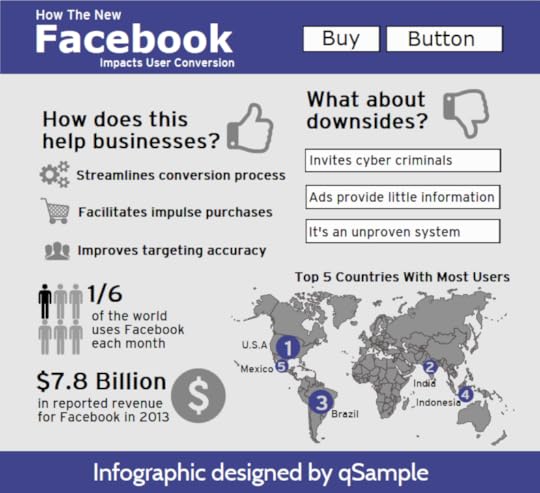
[image error]
Make a Run for Social Media

 So you’ve taken up running. Or maybe you’ve been a long time runner but want to change up you’re training.
So you’ve taken up running. Or maybe you’ve been a long time runner but want to change up you’re training.
It may be hard to find that running community you’re looking for, but one place to turn which you may not have thought of is social media.
How can social media help you enhance your efforts in running?
You may be surprised; some of the ways include:
• Running groups or buddies – It may get a little mundane doing the same run or being by yourself for your workouts. Through social media, you can find running groups or a few running buddies to help motivate you. Start with trying to find a local group on Facebook; you can even use your local running store’s social media sites to start with. (Do make sure it’s legit before meeting up with anyone and be smart about it.)
• Apparel and shoe trends and needs – You can learn a lot through social media on the latest and greatest sports attire. Maybe you want new, better shoes or a new running bra; social media can offer lots of help. You may find help from various merchandisers, from specialty stores to big box merchandisers, like Walmart who is a major retailer of the starter men’s mesh running shoe.
• Training routes – On social media, people like to post their achievements. You can simply get new ideas for running routes by checking out social media, even if you stick to yourself as your training partner. You can also find some motivation here by posting your own routes, accomplishments, goals and achievements. Maybe you’ll inspire another runner to join you on your favorite route or trail.
• Training goals – Since we mentioned goals and achievements, sometimes just listing your own goals on social media gives them more credence and more push from you to achieve them. When you make something public, it has more meaning. So if you post, “Next run I am going to run all the way up the killer hill with NO walking” or “12 miles, here I come!” you may very well be more apt to do it.
• Events and races – Social media is a great way to find out about local or non-local events you may be interested in entering. Whether you’ve participated in the same 5k every year and want to branch out to one more, or you’re on a marathon high, you can find out about events that will be available to you in the future.
So, check out your social media sites for running clubs, retailers, events, and anything running.
Since running can turn into a solitary sport, wherever you are in your running life, social media can help.
You’ll be sure to up your game, plus being a bit more social never hurts!
Photo credit: Image courtesy of Sura Nualpradid / FreeDigitalPhotos.net
About the Author: Heather Legg is an independent writer who focuses on social media, small business, and health articles.
[image error]
July 28, 2014
Social Context Done Right: The November Project
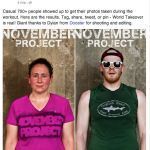
In a recent article on AllFacebook, advertising researcher Eurry Kim said that, “Ads need to resonate with consumers, so an element of ‘emotional reward’ or ‘noticeability’ helps to convey more than just the brand.” I was recently served a Page Like ad on my Facebook timeline that provided the exact kind of social context Kim is talking about.
Last week, my friends Mari and Brett were featured in a photo album along with 700 other participants in the Boston-based November Project. Like a goldfish trained to react to light, I clicked on the album to see what event or organization had my worlds colliding. Questions like, “How do Mari and Brett know one another?” and “Why are my friends sweating before I’ve even had a chance to shower this morning?” raised my eyebrow before I realized that what appeared to be an average post was, in fact, an ad. I immediately liked the November Project’s page to learn more and marveled at how effective the ad was. It was a shining example of how Facebook ads can be useful, attractive and welcome when social context is involved. Why did it work so well?
Social: The ad caught my immediate attention by featuring friends of mine in their natural habitat (my News Feed).
Relevant: The ad was relevant to my interests of Boston-based sports and outdoor activities.
Attractive: The ad was aesthetically pleasing (I’ll only give Mari and Brett half of the credit for this part). The photos were authentic while still being professional.
Social media expert Chris Brogan said in a recent blog post that, “What I don’t love is when an ad of any kind (but definitely these in-stream sponsored ads are kind of the worst) has no real tie to the stream or location where it’s placed.” In the context of Facebook, that stream is news from the people and events that make up the user’s life. If brands want to be part of that conversation, they will need to fit in with that stream.
At the end of the day, the decline in organic reach from brands is meant to open the door for intelligent, relevant ads like this to shine by leveraging Facebook’s social context feature. The networks Facebook users have acquired span all relationships from the deeply personal to professional to casual. The motivations of connections to other users vary and therefore so does the range of curiosities about the way those connections live their lives. The ad showed why Facebook is the most powerful channel for brands and organizations to advertise on today and served the dual purpose of getting the November Project a new fan.
[image error]
25 years of the Internet: How it has changed the way we Interact

Earlier this year, the internet celebrated its 25th Birthday; an invention which has changed the world forever.
Today, there are more than 600million websites worldwide, 500 million tweets are sent every day and an estimated 2.4 billion people go online today. People are now able to access information and share things in a way that was not possible in a previous generation. And as a result, the rise of the internet and social media have changes the way we work, the way we live and the way we communicate and make and maintain friendships.
While some may argue that the internet and social media has caused us to be more unsociable, taking us away from the physical world and hiding behind a screen, others believe that it has enhanced our relationships with people. Sociologist, Barry Wellman states
“Online communication – email, instant messaging, chat rooms, etc. – does not replace more traditional offline forms of contact – face-to-face and telephone. Instead, it adds on to them, increasing the overall volume of contact.”
With so many different ways of communicating, it could be argued that the internet has just increased the overall frequency of communication, allowing us to stay in touch and make social plans with people we already know face to face.
However, the internet has also allowed many people to form completely new relationships with people they never knew and never would have met face-to-face. For instance, the growth of online dating has rocketed – today 33% of couples have met online (which is expected to rise by 70% by 2040) and one million babies have been born from people who met on match.com. Therefore, it is evident that the internet is not only great for communicating with people you already know, but also getting to know people who you never would have necessarily met.
The internet has also changed the way we communicate on a global scale. In Wellman’s terms we have become “glocalized”. Before the internet, people were restricted to a social network that was just local to them including neighbours, friends and family members that were just a short distance away. However, the internet has allowed people to maintain relationships that are both local and long distance. Nowadays, with the increase in smart phones and social media, we can now stay in touch with people wherever you are in the world.
And being able to stay in contact with friends and family on a global basis, has had a massive impact on the way people live. Today, people are much more likely to travel the world, and many are making the bold decision to book their international movers and live the expat lifestyle that they always dreamed- simply because not being able to keep in contact with friends and family is no longer a barrier to discourage them from travelling and living in a new location.
Today, we can stay in touch with people regardless of location – we no longer need to lose touch with those friends from school, or neighbours who move away – the internet has enabled us to keep friends for life whilst still make lots of new ones that are not just restricted to our local town.
So for those people who believe the internet has turned us into unsociable people that hide behind computer screens all day, which admittedly may be the case for the minority of people, the majority of people see the internet as a way to be more social and a way of communicating with people from all over the world.
[image error]
July 25, 2014
3 Ways to Promote Your Business with Facebook

 Facebook has over a billion users, which makes it an excellent marketing tool for small businesses. It offers you an interesting way to reach new potential customers and to form a good relationship with your existing ones. You should start promoting your page as soon as possible to encourage users to check out your content and join your online community. You want to target those who have a real interest in your particular industry, so look for ways to promote your page that will reach your targeted audience the best.
Facebook has over a billion users, which makes it an excellent marketing tool for small businesses. It offers you an interesting way to reach new potential customers and to form a good relationship with your existing ones. You should start promoting your page as soon as possible to encourage users to check out your content and join your online community. You want to target those who have a real interest in your particular industry, so look for ways to promote your page that will reach your targeted audience the best.
Creating useful content to keep your fans interested is a top priority but you need to take things one-step further to encourage your fans to visit your website and eventually become a customer. The best way to accomplish this goal is by using your fan page to promote your business but you have to be subtle about it. You cannot just blatantly advertise your business or you’ll lose fans.
You have to find ways to promote your business on your Facebook page in a way that does not seem like you’re pushing your products on your fans. The best promotional options will depend on the type of business you have but the 3 ways to promote your business with Facebook below will work for most any company.
Promote with Facebook Ads
Using Facebook ads to promote your business has many benefits because they reach your targeted audience. Facebook collects a lot of user data, which means they have the means to target users that have an interest in your particular industry, products or services. As a result, your ads are more effective and they have the potential to reach consumers all across the globe, if you want them to. That’s the great thing about advertising on Facebook, you have so many options it’s easy to find something that works for your business.
Increase Your Fan Base
As you increase your number of fans on Facebook, you’re increasing the number of people that will like and share your posts. You will also increase the number of people that talk to their friends about your company and that is word of mouth advertising, which is the best you can get.
Several options are available to help you encourage people to become a fan such as offering discounts and special deals to your Facebook fans that are not available to anyone else. Another option would be to host a contest to generate interest. When trying to get more followers, it’s better to never buy Facebook likes as it can hurt your reputation and it won’t increase your fan base.
Take Full Advantage of Your Facebook Fan Page
Your Facebook fan page is your first opportunity to promote your business so take advantage of it. This is where you’ll be interacting with your fans, so make sure your page truly represents your company. Customize it to include your logo and anything else that highlights what your business is all about.
When done correctly, people will know exactly what your company does just from looking at your fan page. This will help to create interest in your business, build trust and encourage your fans to check out your company website.
Using these 3 ways to promote your business will help you get the most from this social networking site and enhance your online marketing efforts.
[image error]
7 (little known) Digital Reputation Stats and How to Use Them to Your Advantage

 Digital Reputation is one of those topics where ‘what you don’t know ya don’t know’ could be very damaging. We often think of the mistweet or the incriminating facebook pic when we think of digital reputation, but it is so much more than that. Here are some of the little known stats related to digital reputation. Below each stat is a tip on how you can use this new information to your advantage.
Digital Reputation is one of those topics where ‘what you don’t know ya don’t know’ could be very damaging. We often think of the mistweet or the incriminating facebook pic when we think of digital reputation, but it is so much more than that. Here are some of the little known stats related to digital reputation. Below each stat is a tip on how you can use this new information to your advantage.
1. 88 percent of online adults avoid doing business with companies who they believe do not protect their privacy.
Tip: If you are collecting customer email addresses or banking information, be sure to provide plenty of information and reassurance that their privacy will be protected. This could mean the difference between getting the sale or not. If you’re a small business, perhaps look into linking up with Amazon payments or another method for accepting payments online that is pretty widely accepted/trusted.
3. 4 out of 5 divorce lawyers are turning to Facebook for evidence.
Tip: I’m not even going to pretend to advise people not to post scandalous pictures on social media because that is a given. But, if you are going through a difficult time in your marriage, keep your thoughts to yourself. One status update posted out of anger can be misconstrued and used against you, even if you weren’t at fault.
4. 65 percent of recruiters frowned upon job seekers who sprinkled their posts with profanity.
Tip: Your friends and followers may not care if you drop an f bomb, but the truth is you never know what your future employer will think. Maybe they are part of the 45% that are cool with it, but chances are they are not. Keep it clean and stand out.
5. In the last 2 years, the number of people accessing the Internet via mobile phone has increased by 60.3 percent.
Tip: If you have a blog or website, awesome! These are great for amplifying your digital reputation. But, if your site is not mobile-friendly, it could hurt you. Chances are your name may come up in a search committee meeting, and next thing you know they are checking out your site on their phone before they get back to their desk. Look for plugins or themes that will make your site mobile-friendly.
6. If you have a 100% LinkedIn profile it will show up on the first page of Google search results for your name. (more of a fact rather than a stat)
Tip: Maybe you don’t have a lot of digital footprints out on the interwebs just yet. That’s ok! Start with LinkedIn and be sure to complete 100% of the profile. LinkedIn shows up high on Google Search results, so this way when someone looks you up they will find this before anything else.
7. 68 percent of hiring managers, hired candidates because of something they saw on social media.
Use social media as a platform to share your message with the world. Every little post that shows you in a positive light to employers can help you. Don’t focus solely on protecting or covering your tracks. Work on producing a positive and strong digital reputation.
Want more? Check out my post on the 17 Resources for Digital Reputation, it is chock full of great resources and more insights on the topic.
Sources:
What Happens in Vegas Stays on YouTube, by Erik Qualman: http://bit.ly/1chaRvP
http://www.truste.com/about-TRUSTe/press-room/news_truste_launches_new_trend_privacy_index
http://digiday.com/platforms/1-alarming-stats-social-media/
http://www.prdaily.com/Main/Articles/Study_70_percent_of_companies_have_rejected_job_ca_9704.aspx
[image error]
July 24, 2014
How To Get A (Strong) Recommendation on LinkedIn

A few weeks back, I received a request from a former employee asking for a Linkedin in recommendation. Read the note below and I’ll share why this wasn’t the best approach and 3 tips on how to get a strong detailed recommendation.
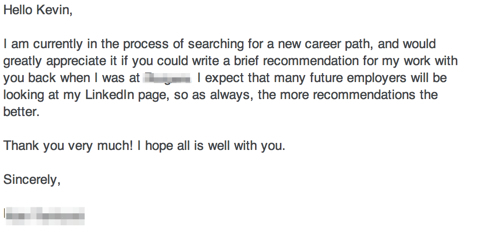
This person was right about one thing, future employers will be looking at his LinkedIn page and recommendations will definitely help. In fact, 89% of all recruiters report having hired someone through LinkedIn. That being said, the approach this person used to obtain the recommendation lacked effort and intentionality. This was coming from a former employee whom I hadn’t spoken to in years and when they did work for me they were part of a much bigger team where I did not have the opportunity to directly supervise them. There wasn’t much of a connection to begin with, and so a note a few years later randomly asking for a recommendation was not motivating at all.
 No matter if you needed recommendations for school or for a job, we all know how important a powerful recommendation can be for your future. That phrase, “it’s not what you know, but who you know” is far too common in today’s workforce. It’s important now, more than ever, in a time of limitless social connection, to use the tools (online and face-to-face) available to you to build your network before you need it.
No matter if you needed recommendations for school or for a job, we all know how important a powerful recommendation can be for your future. That phrase, “it’s not what you know, but who you know” is far too common in today’s workforce. It’s important now, more than ever, in a time of limitless social connection, to use the tools (online and face-to-face) available to you to build your network before you need it.
A majority of employers still require you to provide a list references at some stage in the hiring cycle. Many times, as early as when you hit the “apply” button. When it comes to building your reference list or asking for a recommendation, consider these questions first and foremost.
Who are the 5 most recent connections (former supervisors, colleagues, employees) that can speak to my strengths as an employee and my work ethic?
When was the last time I spoke to them about my desired career path, and do they know I am currently applying to jobs?
Is there anything I can do to help make their life easier when it comes to serving as my reference? (ie. send them your resume, hop on a call to discuss the job, etc)
Often times, college students and young professionals ask for a recommendation from someone that did not directly supervise them and those individuals are unable to cite detailed examples of their work ethic.
If you have a reference in mind and believe they can speak strongly about your work ethic and skills, and you have prepared them with materials or information about the job, then you’re ready for the next step. Now you are fully prepared to ask for that recommendation, and here is how to do it.
1. Do the work
As I mentioned above, prepare some materials for your recommender. Make sure they have information about the job you are applying for and an updated resume. You might want to also jog their memory of a few key projects you worked on with them that can be referenced in the recommendation. Don’t be too pushy, you’ll need to find a balance between providing adequate information and not writing the recommendation for them. The best way to avoid a mishap here is by simply putting yourself in their shoes.
2. Stay in Touch
In 2014, there is no longer an excuse for not staying in touch. Avoid asking for a recommendation from someone who you haven’t (at least loosely) kept in touch with in over a year. Most likely they will not remember the specifics of what made you a great employee or colleague, and they will be unsure of your career path and recent accomplishments. Essentially they won’t be able to speak to what makes you the best candidate for the job. The chances of getting loose connections, those you haven’t spoken to in over a year, to give you a recommendation at all is slim….let alone getting a strong recommendation.
3. Post it Forward
Find your current supervisors, colleagues, and employees on LinkedIn and start writing a genuine recommendations for them. The more timely the better. Especially, after completing a big project, initiating a new venture, or a hitting a major goal for the organization.
The recommendation below was written by a current student that works for my social media team at Rutgers and will be a senior this year.

She is building her network before she needs it, keeping in touch with them, and providing real-time recommendations. In turn, she has immediately landed herself a handful of detailed and powerful recommendations from not only myself but from other well-connected professionals.
The job you love is out there for the taking, but lackluster recommendations are not going to get you there. ‘You get what you put into it’ is a concept that applies to the job search just as much as it does to any other experiences in life.
The Niche Movement is an organization founded on the principle to end employment unhappiness, and this is one of wide range of topics and ideas we share with young people to help them find the career path they will love. If you found this article helpful, you can support The Niche Movement and our ability to continue to do this work, by checking out our Kickstarter campaign. Donating to the campaign will score you our first book that will be chock full of tips and stories just like the ones featured in this article.
[image error]
6 Ways Your Social Media Team Can Improve

You’d be hard pressed to find a business owner or marketer out there who isn’t already well-aware of social media’s importance to their business. But even the most savvy marketing teams can struggle to use social media effectively, whether they’re having difficulty maintaining a rich presence on four different platforms or simply can’t think of anything to say on a consistent basis. If you’re feeling a bit burnt out or lost in the social media sphere, the following six tips will straighten you out.
1. Make Your Profiles Stand Out
Detailed profiles for all of your social media pages are crucial from a user standpoint. After all, the more details you have, the more likely you’ll be to use keywords the search algorithms can rank, as well as links to your wider digital presence so your followers can tap into your entire online brand.
But beyond just this, you want to make sure that your profiles set you apart from your competitors in terms of your voicing and the imagery you use. Your profiles should of course be polished (no typos!) and as personalized as you can get while still being professional. Use details and a sentence-long anecdote that are unique to you or your brand. Make sure your profile photo and cover shot are professionally done, maintaining consistent color branding across platforms. If you display a logo, make sure that’s professionally designed as well. Keep your profile updated with new information and photos in your gallery as well. If you have a local business and are on Google+, make sure to Google it so you can be sure all of your profile images are nicely cropped in the search carousel.
Your profile is the first thing a customer will see, so you really want to hit out of the park!
2. Respond…NOW
Okay, maybe not now-now, but quickly. When customers connect with your brand on social media, it’s not just because they want to see what you’re sharing. Rather, many customers use social media as a customer service tool. Given its public nature, that means your brand can look pretty bad pretty fast if you’re not responding, especially if the customer is escalating their communication either with frequent messages or by posting on other sites. You’ll have a much better interaction if you can mitigate the situation quickly. In fact, you may even want to make a separate customer service account just for that purpose, like the Microsoft XBox support.
Responsiveness is also important when the interaction is positive. A customer who leaves a compliment will feel miffed if you don’t thank them for it in a timely manner. What’s more, leaving a customer hanging means losing out on an opportunity to form a real relationship and build community. So set aside several periods each day to respond.
3. Use Recent Events to Create Relevant Content to Share
Whether you’re on a mission to drive more website traffic via your social platforms or out to attract new followers, tapping into recent events and major news stories is a great way to create and promote relevant content. As an example, take a look at the mobile security company Lookout. First off, they created a piece of content on mobile theft.
While this resource is certainly useful, the Lookout social media team was able to gain more traction and engagement by repurposing the content to be relevant to the World Cup—which was ongoing at the time. The social team then created a Slideshare using that new content this SlideShare:
The Lookout team made sure their content was relevant to World Cup fans before sharing on social. For instance, tips included: safety tips for big crowds, staying off of unknown networks, and not downloading from foreign app stores. Altogether, these are exactly the kinds of tips a huge percentage of people were looking for at the time, which is probably why SlideShare itself shared the presentation on their own feed. Ultimately, Lookout was able to repurpose their existing content and use a trending event to attract attention on Twitter, Facebook, and Slideshare, gaining them new followers and expanding brand awareness.
While newsjacking does present some pitfalls, it’s an excellent strategy for curating and sharing content, as long as you frame it in a way that’s relevant to your followers and won’t be seen as opportunistic.
4. Find Inspiration in Your Followers’ Tweets
Another great place to find content ideas to share or write about yourself is your own followers’ social media feeds. If you’ve grown your network strategically, following only the most relevant fans and focusing on your core offerings, your network is a gold mine, filled with people who are actively asking questions or posting opinions that are relevant to your business. So take the time each week or even each day to see what they’re asking, who they’re responding to and what they’re liking or favoriting so that you can create or curate your own content so that it’s most relevant to their interests.
5. Pay Attention to Shares
Who is re-sharing your posts? When are they sharing them? What kind of posts are most often reshared, and which ones drives the most traffic? These are all questions for your Analytics, though you can also get a quick sense of the kind of content your followers are liking with a glance at the reshare/retweet and like/favorite stats. Both will give you a good grasp of what your followers are engaging with the most, and therefore what kind of content you should create for sharing in the future. Keep in mind, kind of like the Lookout example above, you can always repurpose your content, approaching it through a different lens, with a different theme, or via a different structure to make it new and interesting, while still tapping into those same interests.
6. Make the Most of Social Media Tools
Just going to say this one frankly: if you’re not using Hootsuite, your everyday social media strategy is far more cumbersome than it needs to be. Hootsuite provides numerous functionalities, but its most powerful is its simplest: combining all of your social media feeds into one dashboard, to be easily thumbed through and updated. It also allows you to schedule updates, so you can load them all up at once and concentrate on other tasks throughout the day (this is great from a distraction standpoint). It also now has Nimble integrated, which helps you zero in on specific important relationships you want to make sure you build well.
There are a host of other excellent tools, but one of my favorites for Twitter is JustUnfollow — essential for building an engaged following. With JustUnfollow, you can see who you’re following that isn’t following you back, and you can easily unfollow them right from the platform. This makes it much easier to even out your follower/following ratio. You can also see which of your followers are inactive (no use following them if they’re not even there). You can identify new followers by copying other people’s followers or by entering keywords. Overall, it’s a streamlined and powerful way to grow an engaged network.
In Short
From Facebook to Twitter and Pinterest, social media is a powerful way to grow your customer base and build a community around your brand. With these six tips, you’ll have an avid following in no time!
[image error]





